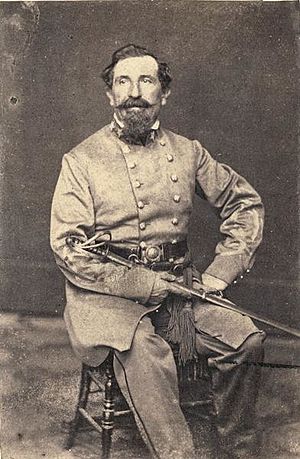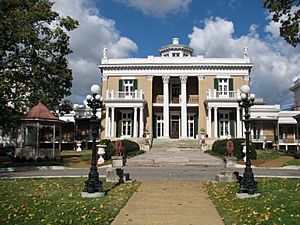Adolphus Heiman facts for kids
Quick facts for kids
Adolphus Heiman
|
|
|---|---|

Col. Adolphus Heiman
|
|
| Born | April 17, 1809 Potsdam, Germany |
| Died | November 16, 1862 Jackson, Mississippi |
| Buried |
Mount Olivet Cemetery
Nashville, Tennessee |
| Allegiance | |
| Service/ |
|
| Years of service | 1846–1847 1861–1862 |
| Rank | (not substantiated) |
| Unit | 1st Tennessee Volunteer Infantry (USA) |
| Commands held | 10th Tennessee Infantry (CSA) 1st Brigade / Left Wing / Army of Central Kentucky |
| Battles/wars | Mexican–American War |
| Other work | architect, engineer |
Adolphus Heiman (born April 17, 1809 – died November 16, 1862) was an architect and soldier. He was born in Potsdam, Prussia, which is now part of Germany. He later became an officer in the Confederate Army during the American Civil War.
Contents
Early Life and Moving to America
Adolphus Heiman was born in Potsdam, Prussia, on April 17, 1809. Prussia was a historical region in Europe. His father worked as a building superintendent.
In 1834, Adolphus moved to the United States. He spent some time in New York City and New Orleans. By 1837, he settled in Nashville, Tennessee.
Career as an Architect and Soldier
From 1837 to 1841, Heiman worked on several building projects. He helped build the First Baptist Church on Fifth Avenue in Nashville. This church was later destroyed in 1940. He also designed tombstones for the Old City Cemetery in Nashville.
Serving in the Mexican-American War
Heiman volunteered to serve in the Mexican–American War (1846–1848). He became a First Lieutenant in the 1st Regiment of Tennessee Volunteers. He was the regiment's Adjutant, which is like a chief administrative officer.
Heiman was wounded during the Battle of Cerro Gordo. He was wounded again at the Battle of Monterrey. When the war ended, he was promoted to Brevet Major. A "brevet" rank is a temporary promotion for good service.
Designing Famous Buildings
After the war, Heiman continued his work as an architect. In 1849, he was asked to build a large state hospital. It was designed in the Gothic Revival style and had 250 beds.
Heiman designed many other important buildings. These included the Cathedral of Our Lady of the Seven Dolors, now called St. Mary's Catholic Church. He also designed the Adelphi Theater, which is no longer standing.
He designed buildings for the University of Nashville. These included the Medical Department and the Literary Department. He also created the Belmont Mansion, a beautiful home in Nashville.
His work wasn't just in Nashville. He designed the Giles County Courthouse in Pulaski, Tennessee. He also designed St. John's College and the Arkansas Masonic School in Little Rock, Arkansas. The First Presbyterian Church in Huntsville, Alabama was another one of his designs.
Heiman even designed the first suspension bridge in Tennessee. This bridge crossed the Cumberland River. By the 1850s, he was known as "Nashville's architect." He was also a Freemason in the local Cumberland Lodge No 8.
Service in the Civil War
Heiman served in the Confederate States Army during the American Civil War. He first became a Major in the Provisional Army of Tennessee. He worked as an aide to Brigadier Robert G. Foster. Later, he became an Assistant Adjutant-General for the Tennessee Military Department. He held the rank of Colonel.
When the 10th Tennessee Infantry Regiment was formed, Heiman was chosen as its colonel and commanding officer. His regiment was stationed at Fort Henry. Heiman then built Fort Heiman on the opposite side of the river.
When the Union Army attacked Fort Henry, his regiment moved to Fort Donelson. At Fort Donelson, Heiman was given command of a brigade, which is a group of regiments.
Prisoner of War
The fort surrendered in February 1862 after the Siege of Fort Donelson. Heiman became a prisoner of war. He was held at Fort Warren in Boston. He became very ill there. After six months, he was released.
Death
After his release, Heiman was immediately taken to a Confederate hospital. He was in Jackson, Mississippi. He died there on November 16, 1862. This was just six days after he was re-elected as colonel of the 10th Tennessee regiment. There was talk of him being promoted to Brigadier General, but this was never officially confirmed.
In 1869, Adolphus Heiman was buried in the Confederate Circle of Mount Olivet Cemetery in Nashville.
Images for kids



